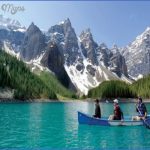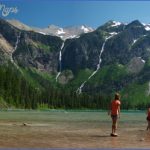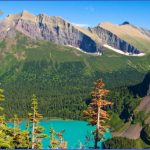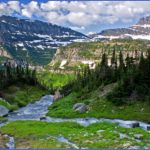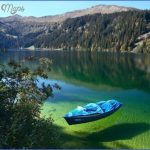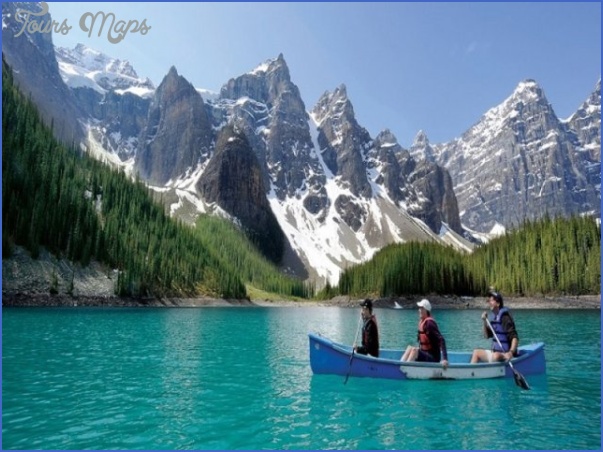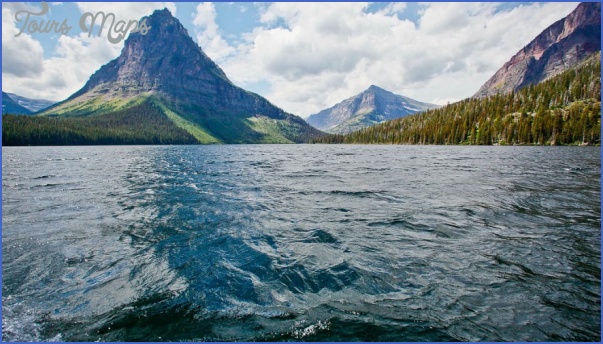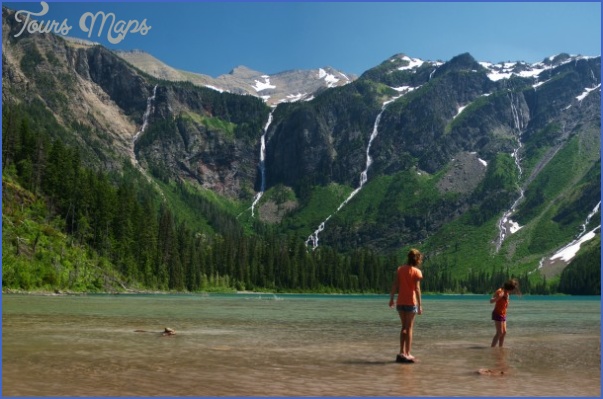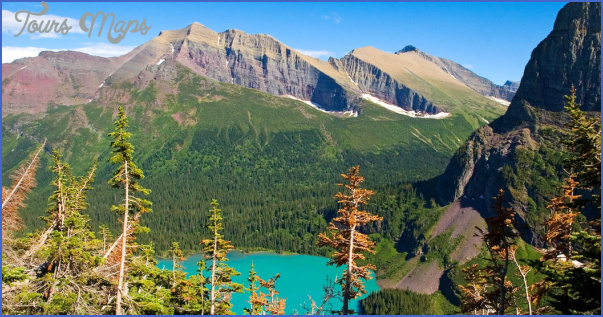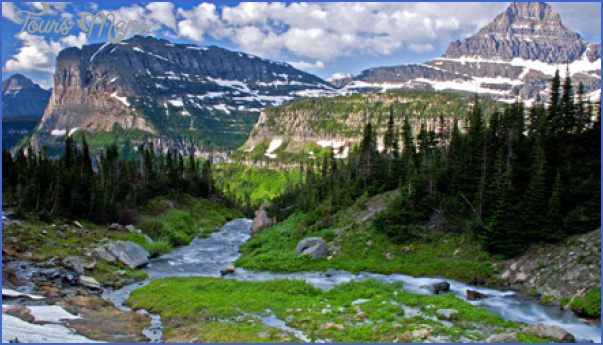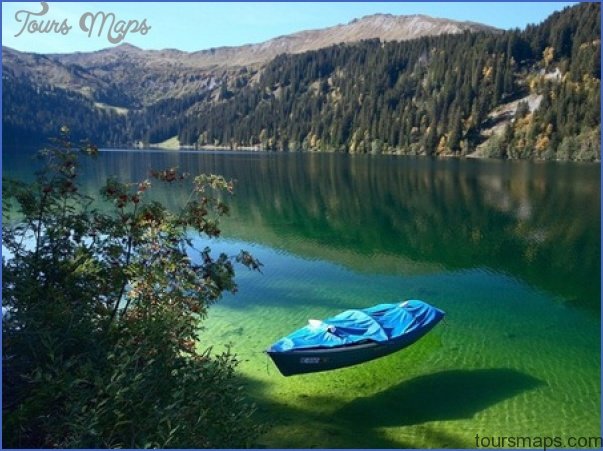LAKE KOOCANUSA, WHICH STRETCHES INTO CANADA, IS KNOWN FOR BOATING AND FISHING
About 45 miles north of Libby, a bridge crosses the lake. If you’re needing a break, continue for about 6 miles on MT 37 into Rexford (pop. 149), which was once on the banks of the Kootenai River but was moved 2 miles to its current location in 1974 after rising lake waters flooded the original town site.
Once back down to the bridge, your navigational skills will be tested. Cross the lake and turn right on Sullivan Creek Road also FS 92 and follow the shoreline about 3 miles before veering west and beginning an ascent into the wild Yaak River country. A well-maintained gravel road climbs over a modest pass, where it remains FS 92 and also becomes the Yaak River Road. As you descend, you’ll meet the tumbling waters of the Yaak from the right. At this point, you’re less than 4 air miles from the Canadian border, and you might even come across a border patrol agent in a telltale white truck with green markings. When the road bends south, FS 276 juts off to the west toward Garver Mountain Lookout, one of four such towers in the area available as a recreational rental. If you’re into roughing it a bit, these are unforgettable experiences.
After following the Yaak through private lands, look on the right for a pioneer cemetery amid the pines. Headstones dating to the late 1800s poke from a carpet of pine needles and are scattered widely around an American flagpole. The gravel road continues past an occasional private residence to the junction at Yaak (pop. 248), home to the Yaak River Tavern & Mercantile (406-295-5159) and the World Famous Dirty Shame Saloon (406-295-5439), now open year-round. The tavern’s back deck serves up pastoral views of the lazy river and a nearby trail leads to trout fishing that remains solid despite decades of logging.
TROY’S LOCATION IN THE MOUNTAINS BELIES ITS ELEVATION Heading south on the Yaak River Road, the first cascade of Yaak River Falls is easily seen from the highway and is quite photogenic. More interesting is the lower drop, where water slides down a flat slab of rock at about a 30-degree angle. Some of the exposed rock here is 1.5 billion years old. Also visible are the remnants of a mining bridge. Built in the 1880s as a route to the now-defunct mining town of Sylvanite, it was the first bridge across the Yaak.
After winding through the woods past many of those mysterious gravel two-track driveways, the Yaak River Road ends at US 2. Turn east to Troy (pop. 957), where the signs boast Lowest in Elevation, Highest in Recreation. Set amid the pines and firs, Troy is the last Montana town before the Idaho state line on the Kootenai River, which collects a goodly portion of western Montana’s waters. At a decidedly un-Montana-like 1,880 feet above sea level, Troy has relatively mild, albeit damp, winters.
Returning to Troy means you’ve completed the loop.
Best Places to Bunk libby: Libby has a few small motels that are comparable in providing adequate overnight stays, but the Venture Inn ($$, 406-293-7711) rates above-average marks. For the B&B experience, congenial hosts Keith and Ellen Johnston have the clean-as-a-whistle Huckleberry House ($$, 406-293-9720) on Main Avenue, with four rooms to choose from and their famous huckle-licious breakfasts starring huckleberry French toast. A few miles out of town, the Bobtail Lodge B&B ($$, 406-2937175) has the creatures to go with the comforts, from wild deer and turkeys to domestic peacocks and laying hens that contribute to the farm-fresh breakfast. For a more secluded getaway, Moose Ridge Cabin ($$, 406-293-3960, May-Oct.) is in a pretty wooded area off US 2, about 14 miles southeast of town. It sleeps up to four, but is most comfortable for a couple. yaak: The hunting and fishing-oriented Yaak River Lodge ($$/$$$$, 406-295-5463) is a busy place down the road a piece from the two bars that make up the entire town. The lodge has six inviting suites, a communal flophouse with bunk beds on two floors, and a private fishing cabin open only in the summer that sleeps twelve. The lodge is situated on the banks of the river, just downstream from town.
SIDE TRACK
Pipe Creek Road (37 miles)
This is the Yaak River country of lore. Once you make the right turn at Yaak and cross the bridge, you’re off the grid for more than 30 miles all the way to Red Dog Saloon & Pizza just north of Libby. The road is a single paved lane through dense thickets of fir, pine, larch and cedar, and the residences visible through the tangle range from primitive to comfortable. There’s no cell service, so locals monitor traffic on CB Channel 22.
Along this route you’re likely to see more deer or grouse than pickup trucks. Find the right local at the Yaak Tavern or Dirty Shame, and they’ll tell you this is the best road for spotting Bigfoot. About five miles after crossing the river at Yaak, turn left at the mailboxes (Viral Lake Road) and go about another five miles to an open meadow where you’ll find one of the resident Sasquatches, in all his glory, standing upright in a field. Don’t panic: he hasn’t moved in years.
Aside from the few homes and a camp for troubled kids that crop up, this drive is all about enjoying the utter stillness and unmistakable scents of conifers, especially cedar. The road carves a trough through towering trees and along the mostly invisible South Fork of the Yaak River until it reaches the Yaak Summit, marked only by spray paint in the road.
Descending toward Libby, you’ll pass the junction for Turner Mountain Ski Area, whose lone lift provides access to twenty-five varied runs, with a 2,110-foot vertical drop from a summit elevation of 5,952 feet. It isn’t Whistler, Sun Valley, Vail, or even Bozeman’s Bridger Bowl, but Turner is among the most remote ski areas in America, so crowds are light. And at $37 for a full-day lift ticket (2014-2015), it’s also light on your wallet.
The isolation of this area is epitomized by its lone interpretive site. Even if you don’t blink you might miss it. Approaching the junction of Forest Service Road 336, just before the road becomes two lanes with yellow center stripes, keep a lookout on your right side. In a small, over-grown clearing you’ll notice a weathered brown Forest Service sign with fading white letters. It explains the story of the first national Christmas tree to come from Montana, a 75-foot Engelmann spruce harvested here and presented to President Eisenhower in 1958. Even though it’s less than 50 feet from the road, you’ll either need binoculars or to scramble down the embankment through the scrub brush to read the sign and good luck finding the stump that’s supposedly still there.
Travel to Montana Photo Gallery
Maybe You Like Them Too
- The Best Cities To Visit in The World
- World’s 10 Best Places To Visit
- Coolest Countries in the World to Visit
- Travel to Santorini, Greece
- Map of Barbados – Holiday in Barbados

